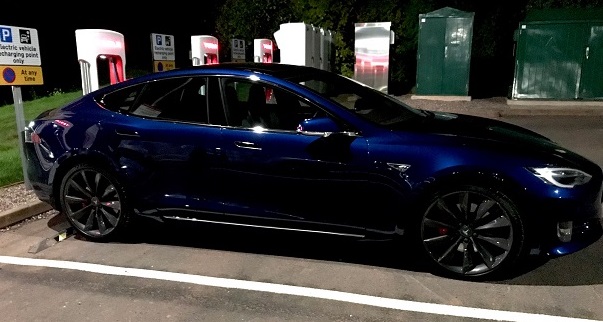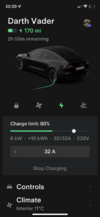Welcome to Tesla Motors Club
Discuss Tesla's Model S, Model 3, Model X, Model Y, Cybertruck, Roadster and More.
Register
Install the app
How to install the app on iOS
You can install our site as a web app on your iOS device by utilizing the Add to Home Screen feature in Safari. Please see this thread for more details on this.
Note: This feature may not be available in some browsers.
-
Want to remove ads? Register an account and login to see fewer ads, and become a Supporting Member to remove almost all ads.
You are using an out of date browser. It may not display this or other websites correctly.
You should upgrade or use an alternative browser.
You should upgrade or use an alternative browser.
Confused charging Tesla from home - anyone able to help ?
- Thread starter s7gpt
- Start date
Louis0w
Member
8Kw is the energy being delivered. 10Kwh is the capacity added so far during your charging session.
The other way around, but yeah that's the idea.They are not as you report them. They are kw and kwh.
One is the amount of fuel put in - 8kw
And the other is the rate of fuel flow - 10kwh
8kW is the rate of charging. 232V*32A roughly 8kW
+10 kWh what you added to the battery in this charging session
MrBadger
Badger out
8kW power - how fast the water is flowing
10kWh energy - how much water is in the sink
10kWh energy - how much water is in the sink
is 8kw about right or should I be seeing more, I have a Tesla gen 3 which I thought was rated at 11kw ?8kW power - how fast the water is flowing
10kWh energy - how much water is in the sink
7kw (32amp) is about right for single phase, the gen 3 needs 3 phase to output 11kwis 8kw about right or should I be seeing more, I have a Tesla gen 3 which I thought was rated at 11kw ?
The exact figure is dependant on voltage being supplied which in the UK can vary between min and max defined limits
Read the manual!thanks everyone - first day with new car so lots to learn...
Seriously, the majority of questions new users have can be answered by looking at the manual or searching on here. We'll await your "I'm not getting the range I expected" thread. Seems every new user needs their own thread for that one
Jason71
Well-Known Member
Also should we be helping the Dark Lord of the Sith?Read the manual!
Seriously, the majority of questions new users have can be answered by looking at the manual or searching on here. We'll await your "I'm not getting the range I expected" thread. Seems every new user needs their own thread for that one
This is a fairly decent guide that talks you through the terminology, the different charge points, while tesla sometimes use miles and not kWh and what means etc which might be worth a read. While the manual is ok, it still assumes you know the basics

 tesla-info.com
tesla-info.com

Charging a Tesla FAQ
Everything you need to know/FAQ about charging a Tesla, including home chargers, destination chargers, rapid chargers and Superchargers
Perhaps some uncharitable comments about reading the manual, the wall connector manual isn't very clear. Some general reading/watch around EV topics would have show the answer.is 8kw about right or should I be seeing more, I have a Tesla gen 3 which I thought was rated at 11kw ?
The Tesla Wall Connector can supply upto the limit that your car will accept, 11KW on AC power. Faster chargers than this will all be DC.
In order to supply 11KW your house would need to be supplying 3 phase power, 3 x 16Amp, this isn't very common in UK houses. Most properties have single phase power, so Tesla uses two modules 2 x 16A to give 32A of charging.
So to get to KW, we multiple A by Volts, a typical UK figure is 230V, that gives 32 x 230 = 7.36KW. Most people will refer to a 32A charger as being 7KW. It's likely that you've got a higher voltage than the average (there is a wide range), which is why it's just showing a rounded up figure of 8KW, the reality is you are generally getting somewhere between 7.3 and 7.6KW
So you are getting exactly what you should expect for a regular UK house, sometimes it will say 7, sometimes 8, the real figure is roughly halfway between.
Totally agree, we tend to use far more of the features of a Tesla than other cars and the manual is very clearly written. It helps that all the cars are more or less the same, my previous BMW manual was impossible as every paragraph depended on which options you had selected, engine size, trim level etc.My comment was not specifically about charging but guidance for a new user. A lot of the questions we get on here can easily be found in the manual. If the OP has a lot to learn then its a great place to start.
That's a good point. I'd forgotten about that minefield with BMW - and the supplementary books dependent on your choice of infotainment.Totally agree, we tend to use far more of the features of a Tesla than other cars and the manual is very clearly written. It helps that all the cars are more or less the same, my previous BMW manual was impossible as every paragraph depended on which options you had selected, engine size, trim level etc.
Terry F
Model 3 owner
Due to collect my M3 RWD tomorrow which of course will have LFP battery. Just got an SMS from Tesla telling me to charge regularly to 100% and to charge to 100% as soon as possible after taking delivery - to maximise performance of the battery. Tesla clearly making sure that new owners understand the different charging strategies for different versions of M3.
Thats actually because there seems to be a fault at the moment. If you don't charge an LFP to 100% regularily then there is a risk the new Lithium-Ion Low Voltage battery will go flat quickly, something to do with main battery caliubration, especailly when the main battery drops below 20%. They'll probably make it more tolerant to the problem with a software update at some point but the big push at the moment is to stop people accidently bricking their new cars.Due to collect my M3 RWD tomorrow which of course will have LFP battery. Just got an SMS from Tesla telling me to charge regularly to 100% and to charge to 100% as soon as possible after taking delivery - to maximise performance of the battery. Tesla clearly making sure that new owners understand the different charging strategies for different versions of M3.
Don't worry about it though, just stick it on a 100% charge as soon as you can and until then try to avoid dropping below 20%.
spdpsba
Active Member
My understanding is this is applicable only to the Model 3 with the new low voltage batteries and the li-ion battery on vehicles equipped with LFP batteries can die in less than 20 minutes after the vehicle’s main battery reaches a state of charge of less than 10%. When this happens, the car cannot be started or even charged.Thats actually because there seems to be a fault at the moment. If you don't charge an LFP to 100% regularily then there is a risk the new Lithium-Ion Low Voltage battery will go flat quickly, something to do with main battery caliubration, especailly when the main battery drops below 20%. They'll probably make it more tolerant to the problem with a software update at some point but the big push at the moment is to stop people accidently bricking their new cars.
Don't worry about it though, just stick it on a 100% charge as soon as you can and until then try to avoid dropping below 20%.
Similar threads
- Replies
- 8
- Views
- 647
- Replies
- 11
- Views
- 541
- Replies
- 33
- Views
- 2K
- Replies
- 15
- Views
- 2K



